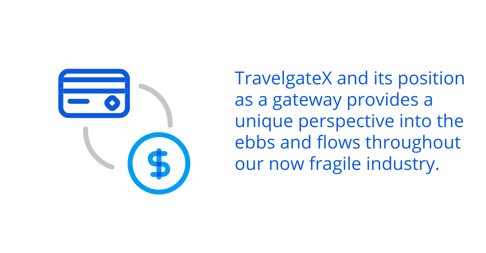Billing and the ongoing credit crisis in travel mid and post Covid-19
Posted by Content

You’ve heard the answer to the following question countless times, likely more than your fair share at that: “Where were you when the Government declared a state of alarm and enforced the first national lockdown?” Much like our names, job titles and compelling 30 second cocktail-party propositions, many of us - through sheer necessity at times - have scripted those very uncertain days of our lives into the all too classic “elevator pitch”.
With particular respect to the travel industry, and second to the above question, you’re probably still getting the “How has it been for you guys, that side?” question. The business equivalent of “what’s your star sign?” - the answer to this question could bear significance (“are these guys about to sink?”) Or could mean absolutely nothing - if the answer is we are growing and doing well.
Further down the rabbit hole of mid and post Covid-19 questions, if you’re still waiting for your share presentation on Zoom to load - you just may get the “and your clients? How are payments looking?” This painful question forms the basis of our discussion here - billing (‘remittances’, depending on where you find yourself reading this today).
Billing, some may argue, is the single most universal trait of any ‘for-profit organization’ - because after all is said and done - via SaaS, PaaS, Online or Offline… Did you get paid?
And perhaps most importantly, how? The cost of doing business is as high as it has ever been before.
With little or no access to credit lines, organizations can no longer solely rely on their credibility to generate future income because of the simple fact that they, and a vast majority of their peers, no longer have unconstrained access to liquidity.
Let's take a deeper dive into the history of liquidity, what that may imply for the travel industry today a few key indicators that support the notion that we are ‘simply’ in the midst of a liquidity crisis (the final wave).
Before we dust off the history books, some housekeeping - what is exactly a liquidity crisis?
Investopedia defines it as “...a financial situation characterized by a lack of cash or easily-convertible-to-cash assets on hand across many businesses or financial institutions simultaneously”
Our earliest encounters with this commercial plague dating as far back as the Song Dynasty (960-1279) in China, where an inability to pay farmers in the fiat currency of the day resulted in a literal meltdown… People would melt the then copper currency because the base metal was worth more than the face value guaranteed by the Dynasty (Batten, 2014).
Why do we look so far back and what does that have to do with us? Albeit the black swan event (more aptly described as a saga) is and was unique to a “globalized” human race - this particular repercussion, with all its nuances, is nothing new to us. Moreover, we’ve solved this problem before - countless times across many other industries.
The earliest records describe a trailblazing Italian visionary, Giovanni Medici, the founding father of modern banking, addressing and solving this very issue in a single lifetime. (He ate innovation for breakfast and likely would’ve run circles around Steve Jobs - check him out.)
The numbers are clear (Covid Economics, Issue 80, 9 June 2021), the “final wave” is upon us, we don’t even need our fancy AI models, complex dashboards and real-time telemetrics to see that:
- Consumers not only yearn to travel (organic search traffic) but, endeavour to do so (quote traffic)
- There is sufficient product (emphasis on sufficient)
- As more and more destinations open and where organizations have found the requisite means to exchange currency, room nights sold rise.
With respect to the second part of point 3, today - what is available to us as an industry?
A lot. None of which, I would add, are the “silver bullet” your board would love to execute, crack open the Hillrock Double Cask Rye Whiskey under Bob’s desk and call it a day. Unlike the Chinese merchants under the Song Dynasty and their Italian counterparts a few hundred years later - in a vanilla B2B context, we have a lot more options;
Option 1: A contractual, invoice driven agreement that is actualised via bank transfer
The 'contract' portion (and the payment terms thereof) are wherein lie our issue. Relatively cheap in execution costs, however, the industry-standard 30-day payment terms in a zero credit insurance environment is simply a risk appetite not many organisations are able to reconcile with amidst Covid-19. You're left with a few more levers (each with its own limitations as well) before declaring the transaction unviable,
- Stricter terms. 30 days could be turned into 14.7 or even a daily balance clearance.
Albeit great for your overall exposure - depending on where you're conducting business, this could come at a hefty transaction fee. Not to forget, the presupposition of having adequate administrative systems to handle this.
- Good ol' fashioned Bartering - brute caveman style - because that's all it really is. You're fortunate to act both as a vendor of room nights and a consumer. This will afford you the opportunity to reach highly effective bilateral agreements that would mitigate exposure on your entities balance sheet. However, there is a simple reason why the world turned away from this type of trade centuries ago - you have what William Jevons described (in his 1875 groundbreaking release of "Money and the Mechanism of Exchange") as a 'double coincidence of wants'. It's a taxing exercise to reach this sort of arrangement and if you're seasoned enough - you'll know they're perfect until one end encounters disputes - I needn´t expand more - if you know, you know.
Of course, you could always require your clients to have a floating deposit... In 2021... Not easy.
Option 1: You could choose to follow this path and execute the transfer by charging a Credit Card.
Option 2: Virtual Credit Cards, tokenization and QR Codes: Pay per transaction. Fantastic idea - we have a fantastic use-case here in the US and their high propensity to transact on a B2B level using credit cards.
It's baked into the culture and with the stiff competition between vendor card providers available to consumers - it's relatively cheap to transact. This environment, amongst other key factors, has fostered fertile ground for businesses to get on with doing business. Limited, of course, in geographical scope by the fiscal jurisdiction you find your organisation and vendor registered. To the global east, the adoption of Alipay and WeChat Pay (and Union Pay, being linked by default to every bank account in China) constitute 90% of the payments system market. And as you can imagine, post covid-19, they´re ramping up B2B facilities at breakneck speeds. I can confidently write that if you seek to sell anything to a consumer in China today (in all earnest) you would be remiss for not fully adopting at least one of three platforms.
Option 3: Independent [standalone] P2P Wallets (Disclaimer, my personal favourite and thus bias will shine shamelessly here)
The ability to segment your business operations, commercial contracts and treasury whilst having logical coherence amongst the three themes is made possible via the very same 4IR´esque bleeding-edge technologies we rely on for our highly competitive digital products.
With daily access to billions of search hits handled at an average of 400 ms per request, over time one cannot ignore the patterns and insights derived from who eventually quotes and books. Reconciling these facts with our clients through highly intentional commercial efforts, we are left with two major conclusions;
- Those inundated with the administration of getting paid, do well.
- Those unburdened by the cost of the above convenience, do better.
In conclusion, the scale of impact that Covid-19 had on [particularly] the travel industry was astronomical. As an industry, we're still watching it play out. I would however like to say that the impact goes both ways. There are a lot of good news stories out there - we see it playing out in the metrics every day. What is the Takehome? What you sell and how you get paid for it needn't be a toxic relationship.


